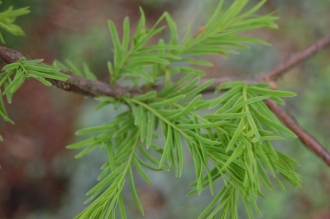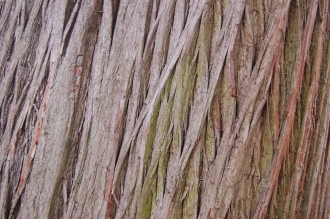Position: Full sun to dappled shade
Flowering period: Spring
Soil: Moist
Eventual Height: 40m
Eventual Spread: 15m
Hardiness: 6a, 6b, 7a, 7b, 8a, 8b, 9a, 9b, 10a
Family: Cupressaceae
Taxodium distichum is an upright, deciduous coniferous tree. Its mid green leaves are spirally arranged on the stem, but twisted at the base to lie in two horizontal ranks, up to 2cm long and 2mm broad. Its leaves appear light green in spring and turn dark orange before dropping in autumn. Its branches are more or less horizontal and its trunk may achieve a diameter of 3m. Its bark is red/ brown, vertically fissured with a stringy texture. Its flowers are monoecious and male flowers are borne in pendulous clusters which are up to 13cm long. Its fruit is a globe shaped cone, that appears green and matures to brown and are up to 3.5cm in diameter. Its roots form aerial roots known as pneumatophores or ‘knees’ at water level which enable this tree to be grown in very wet conditions.
Taxodium distichum, commonly known as the Baldcypress, Southern Cypress, White Cypress, Gulf Cypress or Swamp Cypress, is native to the south eastern United States. It was introduced into the UK in 1640 by the plant hunter John Tradescant.
The etymological root of the binomial name Taxodium is derived from the Latin Taxus ‘the Yew’ and the suffix oides meaning ‘like’. Distichum is derived from the Greek distichos meaning ‘two ranked’, in reference to the leaf arrangement.
The landscape architect may find Taxodium distichum useful as an attractive specimen tree. It is very useful in wet areas including pond edges, river edges and soils prone to flooding as it can tolerate waterlogged soils.
Ecologically, Taxodium distichum cones are attractive to squirrels and other mammals.
The Royal Horticultural Society has given Taxodium distichum their prestigious Award of Garden Merit in 1993.
Taxodium distichum prefers moist, humus rich soils. It tolerates most pH of soil, although it prefers acidic soils.
Taxodium distichum requires little maintenance.








what other tree did this bald cypress tree
mix with to get how it is today or how it grows
i just want to know how did it get mixed and with
what other tree did it mix with to be a “bald cypress tree”
i really wonder
& i wonder about the cedar trees and bushes to
like where does the redness come from and from what other tree
is it i know the tan/white part of the cedar bush is pine and i know that the
cedar part of the cedar bush is the pinkish-red part cedar but what does that part come
from from what other tree has the same color as that and smell
to me its very maddening not know i just sure would like to know but i don’t know
im sure some scientist person would know or they would know what im talking about
is all i just might figure it out my self in time but i haven’t yet.
& the red slimy yew seeds look nothing like the bald cypress seed-cones but when you cut into the yew bush it smells the same as the bald cypress seeds when they are still green and you smash one it has the same smell as the yews do and a very very slight sweet taste to the bald cypress seeds but they smell good